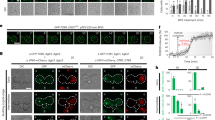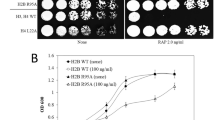Abstract
The TOR proteins are known as key regulators of cell growth in response to nutritional and mitogenic signals and as targets for the immunosuppressive and anti-cancerous drug rapamycin. The fission yeast Schizosaccharomyces pombe has two TOR homologues, tor1 + and tor2 +. Despite their structural similarity, these genes have distinct functions: tor1 + is required under starvation, extreme temperatures, and osmotic or oxidative stress conditions, whereas tor2 + is required under normal growth conditions. Surprisingly, rapamycin does not seem to inhibit the S. pombe TOR-related functions. Rapamycin specifically inhibits sexual development in S. pombe, and this seems to stem from direct inhibition of the S. pombe FKBP12 homologue. Why S. pombe cells are resistant to rapamycin during the growth phase is as yet unclear and awaits further analysis of the TOR-dependent signaling pathways.
Access this chapter
Tax calculation will be finalised at checkout
Purchases are for personal use only
Preview
Unable to display preview. Download preview PDF.
Similar content being viewed by others
References
Chen J, Zheng XF, Brown EJ, Schreiber SL (1995) Identification of an 11-kDa FKBP12-rapamycin-binding domain within the 289-kDa FKBP12-rapamycin-as-sociated protein and characterization of a critical serine residue. Proc Natl Acad Sci U S A 92:4947–51
Chiu MI, Katz H, Berlin V (1994) RAPT1 a mammalian homolog of yeast Tor interacts with the FKBP12/rapamycin complex. Proc Natl Acad Sci U S A 91:12574–8
Crespo JL, Daicho K, Ushimaru T, Hall MN (2001) The GATA transcription factors GLN3 and GAT1 link TOR to salt stress in Saccharomyces cerevisiae. J Biol Chem 276:34441–34444
Cruz MC, Cavallo LM, Gorlach JM, Cox G, Perfect JR, Cardenas ME, Heitman J (1999) Rapamycin antifungal action is mediated via conserved complexes with FKBP12 and TOR kinase homologs in Cryptococcus neoformans. Mol Cell Biol 19:4101–12
Davey J (1998) Fusion of a fission yeast. Yeast. 14:1529–66
Desai BN, Myers BR, Schreiber SL (2002) FKBP12-rapamycin-associated protein associates with mitochondria and senses osmotic stress via mitochondrial dysfunction. Proc Natl Acad Sci U S A 99:4319–4324
Forsburg SL (1999) The best yeast? Trends Genet 15:340–4
Gupta S, Campbell D, Derijard B, Davis RJ (1995) Transcription factor ATF2 regulation by the JNK signal transduction pathway. Science 267:389–93
Hall MN (1996) The TOR signalling pathway and growth control in yeast. Biochem Soc Trans 24:234–9
Helliwell, SB, Wagner, P, Kunz J, Deuter-Reinhard M, Henriquez, R, Hall MN (1994) TOR1 and TOR2 are structurally and functionally similar but not identical phosphatidylinositol kinase homologues in yeast. Mol Biol Cell 5:105–118
Heitman J, Mowa NR, Hall MN (1991) Targets for cell cycle arrest by the immunosuppressant rapamycin in yeast. Science 253:905–9
Gingras A. C, Raught B, Sonenberg N (2001) Regulation of translation initiation by FRAP/mTOR. Genes Dev 15:807–826
Kato T Jr, Okazaki K, Murakami H, Stettler, S Fantes PA, Okayama H (1996) Stress signal mediated by a Hogl-like MAP kinase controls sexual development in fission yeast. FEBS Lett 378:207–12
Kawai M, Nakashima A, Ueno M, Ushimaru T, Aiba K, Doi H, Uritani M (2001) Fission yeast tor1 functions in response to various stresses including nitrogen starvation, high osmolarity, and high temperature. Curr Genet 39:166–74
Koltin Y, Faucette L, Bergsma DJ, Levy MA, Cafferkey R, Koser PL, Johnson RK, Livi GP (1991) Rapamycin sensitivity in Saccharomyces cerevisiae is mediated by a peptidyl-prolyl cis-trans isomerase related to human FK506-binding protein. Mol Cell Biol 11:1718–23.
Lorenz MC, Heitman J (1995) TOR mutations confer rapamycin resistance by preventing interaction with FKBP 12-rapamycin. J Biol Chem 270:27531–7
Matsuo T, Kubo Y, Watanabe Y, Yamamoto M (2003) Schizosaccharomyces pombe AGC family kinase Gad8p forms a conserved signaling module with TOR and PDK1-like kinases. EMBO J (in press)
Rohde J, Heitman J, Cardenas ME (2001) The TOR kinases link nutrient sensing to cell growth. J Biol Chem 276:9583–6
Samejima I, Mackie S, Warbrick E, Weisman R, Fantes PA (1998) The fission yeast mitotic regulator winl+ encodes an MAP kinase kinase kinase that phosphory-lates and activates Wisl MAP kinase kinase in response to high osmolarity. Mol Biol Cell 9:2325–35
Schmelzle T, Hall MN (2000) TOR, a central controller of cell growth. Cell 102:253–262
Shiozaki K, Russell P (1996) Conjugation meiosis and the osmotic stress response are regulated by Spc1 kinase through Atf1 transcription factor in fission yeast. Genes Dev 10:2276–88
Takeda T, Toda T, Kominami K, Kohnosu A, Yanagida M, Jones N (1995) Schizosaccharomyces pombe atf1+ encodes a transcription factor required for sexual development and entry into stationary phase. Embo J 14:6193–208
Van Duyne GD, Standaert RF, Karplus PA, Schreiber SL, Clardy J (1993) Atomic structures of the human immunophilin FKBP-12 complexes with FK506 and rapamycin. J Mol Biol 229:105–24
Weisman R, Choder M, Koltin Y (1997) Rapamycin specifically interferes with the developmental response of fission yeast to starvation. J Bacteriol 179:6325–34
Weisman R, Choder M (2001) The fission yeast TOR homolog tor1+ is required for the response to starvation and other stresses via a conserved serine. J Biol Chem 276:7027–32
Weisman R, Finkelstein S, Choder M (2001) Rapamycin blocks sexual development in fission yeast through inhibition of the cellular function of an FKBP 12 homolog. J Biol Chem 276:24736–42
Wood V, Gwilliam R, Rajandream MA, Lyne M, Lyne R, Stewart A, Sgouros J, Peat N, Hayles J, Baker S et al (2002) The genome sequence of Schizosaccharomyces pombe. Nature 415:871–80
Author information
Authors and Affiliations
Editor information
Editors and Affiliations
Rights and permissions
Copyright information
© 2004 Springer-Verlag Berlin Heidelberg
About this chapter
Cite this chapter
Weisman, R. (2004). The Fission Yeast TOR Proteins and the Rapamycin Response: An Unexpected Tale. In: Thomas, G., Sabatini, D.M., Hall, M.N. (eds) TOR. Current Topics in Microbiology and Immunology, vol 279. Springer, Berlin, Heidelberg. https://doi.org/10.1007/978-3-642-18930-2_6
Download citation
DOI: https://doi.org/10.1007/978-3-642-18930-2_6
Publisher Name: Springer, Berlin, Heidelberg
Print ISBN: 978-3-642-62360-8
Online ISBN: 978-3-642-18930-2
eBook Packages: Springer Book Archive




